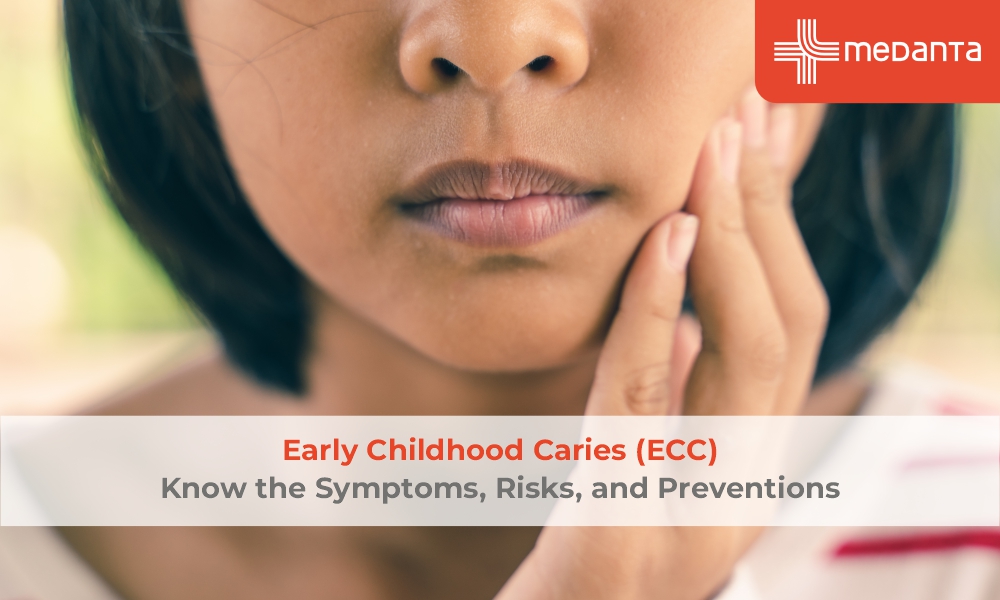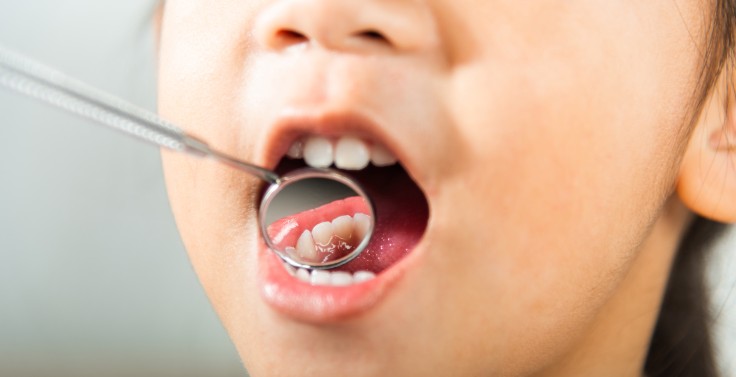Early Childhood Caries (ECC): Know the Symptoms, Risks, and Preventions

People ake the assumption that tooth decay only starts in adulthood, but you should know that tooth decay is very common in young children if proper dental care is not taken. Worldwide, about 20 to 30% of children between the ages of two and eleven have cavities, and tooth decay is particularly aggressive in very young children. It can cause infections that develop into medical problems, which is particularly troublesome since dental decay in very young infants frequently goes untreated.
Early childhood caries (ECC) is a serious and incapacitating condition that affects young children in both developed and developing nations. The total prevalence of dental caries in India is almost 55%, a highly alarming number! What’s more, many parents in India are not even aware of the disease and may neglect the condition when it first appears due to their lack of knowledge. So, let’s discuss the symptoms and prevention methods of ECC to help you learn about the constitution better.
What is Early Childhood Caries?
The chemical breakdown of the tooth surface brought on by bacteria-caused carbohydrate fermentation is known as dental caries. The maxillary incisors are frequently the first to be affected by ECC, a particularly severe kind of dental caries in children. The mandibular incisors, which are shielded from the tongue and saliva, exhibit distinctive sparing and are comparatively less impacted by early childhood caries. Because ECC is frequently linked to improper feeding methods, it was once known as baby bottle tooth decay!
If treatment is postponed or proper child dental care is not practised, practically every tooth may become severely affected by this disease. Lack of dental education is one of the factors contributing to ECC. Thus, it's critical to inform the public about the ways to improve oral health, such as frequent toothbrushing and fluoride exposure.
What Are the Symptoms of Early Childhood Caries?
ECC starts as White Spot Lesions (WSL), which are chalky patches on the tooth surface that are frequently seen beneath plaque. WSL demineralises the tooth surface because plaque dissolves the tooth minerals. However, at this point, the decay is still reversible and painless. But without treatment, the tooth surface deteriorates to create a cavity as demineralisation advances in the child’s teeth. If left untreated, ECC can cause:
Discomfort
Swelling
Trouble eating
Harm to the permanent teeth that are still growing
Infection in all the teeth (in extreme situations)
What are the Risk Factors of Early Childhood Caries?
1. Streptococcus Mutans Bacterium (SM) Infection
Strptococcus mutans (SM) is the bacteria most closely associated with the beginning of caries, and mothers who have elevated SM levels due to untreated dental caries may be more vulnerable to early bacterial transmission to their children. Significant sources of transmission may also come from siblings and other family members!
2. Dietary Habits
What parents should know about ECC is that the emergence of the first tooth marks the start of the critical phase for ECC! The young enamel is particularly susceptible to the acidic results of carbohydrate fermentation, and extended bottle feeding of sweetened infant formula or milk, particularly at night, creates the ideal conditions for the growth of cariogenic (or caries-causing) bacteria. Parents should also remember that caries risk is greatly increased by frequent nighttime nursing beyond the age of twelve months, as well as by consuming sweetened medicines or sugary foods or drinks regularly.
3. Low Fluoride Exposure
It has long been known that children who receive fluoride often have reduced caries rates! The ideal level of fluoride in drinking water is between 0.7 and 1.2 parts per million, and ECC may be more likely to develop in children who live in places with low fluoride water supplies (<0.6 ppm). This happens particularly if they are not exposed to additional fluoride sources.
4. Children With Special Care Needs
Dental caries is more likely to occur in teeth that have developmental abnormalities in the enamel, which are linked to premature birth, low birth weight, and severe diseases during the neonatal period.
How to Prevent Early Childhood Caries in Children?
Preventing early childhood caries is possible by implementing several practices to maintain a good oral lifestyle and dental hygiene care at home. Here are some strategies that doctors recommend to prevent early childhood caries.
Changing Dietary Requirements
A poor diet is one of the main reasons for ECC. Thus, it is crucial to use appropriate newborn feeding practices and a nutritious diet to prevent a child's likelihood of forming early childhood cavities. Breastfeeding reduces a baby's risk of dental cavities because it provides vital vitamins and minerals, and slightly older children should also be encouraged to eat a variety of foods to get the right proportion of nutrients.
Foods like fruits, lentils, beans, and root vegetables might be included in their diet. Remember, any diet high in sweets, even unsweetened natural juices, should be avoided because sugar intake increases the likelihood that ECC may develop.
Correct Amount of Fluoride Exposure
Increasing your child's exposure to fluoride products is another method of treating early childhood cavities because fluoride is a crucial element that aids in lowering the incidence and severity of tooth cavities. Fluoride may be added to a child's daily routine in two major methods to help prevent tooth cavities. With systemic exposure, fluorides are added to drinking water to provide a secure, practical solution, and drinking milk is another excellent source of fluoride for children!

The Effects of Untreated Early Childhood Caries
Cavities in infant teeth can become quite serious if they are not treated. Untreated cavities in infants and toddlers can cause a number of immediate and long-term health problems.
Pain | Tooth sensitivity and pain may result from the cavity's exposure to the tooth's second layer, the dentin, once it has penetrated the dental enamel layer. As the cavity deepens, the bacterial infection may migrate to the dental pulp, the tooth's nerve-filled core, causing a lot of pain. |
Premature tooth loss | Early tooth loss from caries can result in biting abnormalities and crooked teeth, among other long-term dental concerns. Eating issues, trouble speaking, and cosmetic problems will also result from this. |
Infections | Cavities can result in severe and painful infections of a child's tooth pulp, and if treatment is not received, it can spread to other areas of the child's body. In severe situations, untreated caries might even lead to potentially fatal illnesses like Ludwig's Angina and brain abscesses. |
Final Words
Early childhood caries is one of the most common dental issues that affect children worldwide! Children who are impacted may have severe pain, dental deformity, and a lower quality of life if treatment is not received. If you notice any tooth decay or cavities in your child’s teeth, then take them to an expert dentist today! They’ll offer personalised advice on how you can improve your child’s dental health.
FAQs
1. What are the early signs of early childhood caries?
Early signs include white spots or lines near the gum line, especially on the upper front teeth. As it progresses, you may notice brown or black spots.
2. How can I prevent early childhood caries in my child?
Start cleaning your child’s gums with a soft cloth before teeth appear, and brush their teeth twice daily with fluoride toothpaste once they erupt.
3. Is it necessary to treat cavities in baby teeth?
Yes, untreated cavities can lead to pain and infections and can affect the development of permanent teeth.
4. How does fluoride help in preventing early childhood caries?
Fluoride strengthens tooth enamel, making it more resistant to acid attacks from plaque bacteria and sugars in the mouth.
5. When should I first take my child to the dentist?
The first dental visit should be by the child’s first birthday or within six months after the first tooth appears.
Citations
Anil, S., & Anand, P. S. (2017). Early Childhood caries: prevalence, risk factors, and prevention. Frontiers in Pediatrics, 5. https://doi.org/10.3389/fped.2017.00157
Dental caries (Tooth decay) in children ages 2 to 11 years. (n.d.). National Institute of Dental and Craniofacial Research. https://www.nidcr.nih.gov/research/data-statistics/dental-caries/children
Dülgergil, Ç., Dalli, M., Hamidi, M., & Çolak, H. (2013). Early childhood caries update: A review of causes, diagnoses, and treatments. Journal of Natural Science Biology and Medicine, 4(1), 29. https://doi.org/10.4103/0976-9668.107257
Evans, E. W., Hayes, C., Palmer, C. A., Bermudez, O. I., Cohen, S. A., & Must, A. (2013). Dietary intake and severe early childhood caries in Low-Income, young children. Journal of the Academy of Nutrition and Dietetics, 113(8), 1057–1061. https://doi.org/10.1016/j.jand.2013.03.014
Marwah, N., Nigam, A. G., Yadav, S. P., Meghpara, M., Godhani, S., & Chalana, S. (2022). Association of Early Childhood Caries with Feeding, Dietary Habits, and Oral Hygiene Practices among Rural and Urban School Children of Jaipur. International Journal of Clinical Pediatric Dentistry, 15(3), 273–279. https://doi.org/10.5005/jp-journals-10005-2396
Muthu, M. S., Ganesh, A., Anandan, S., Thiruvengadam, G., Padmanabhan, R., & Nuvvula, S. (2024). Association of parent-reported timing of first tooth emergence and ECC: a secondary analysis of a case-control study. European Archives of Paediatric Dentistry, 25(4), 561–567. https://doi.org/10.1007/s40368-024-00914-6
Nassar, Y., & Brizuela, M. (2023, March 19). The role of fluoride on caries prevention. StatPearls - NCBI Bookshelf. https://www.ncbi.nlm.nih.gov/books/NBK587342/
Olczak-Kowalczyk, D., Krämer, N., Gozdowski, D., & Turska-Szybka, A. (2023). Developmental enamel defects and their relationship with caries in adolescents aged 18 years. Scientific Reports, 13(1). https://doi.org/10.1038/s41598-023-31717-2
Pandey, P., Nandkeoliar, T., Tikku, A. P., Singh, D., & Singh, M. K. (2021). Prevalence of dental caries in the Indian population: A systematic review and meta-analysis. Journal of International Society of Preventive and Community Dentistry, 11(3), 256–265. https://doi.org/10.4103/jispcd.jispcd_42_21
Tham, R., Bowatte, G., Dharmage, S., Tan, D., Lau, M., Dai, X., Allen, K., & Lodge, C. (2015). Breastfeeding and the risk of dental caries: a systematic review and meta‐analysis. Acta Paediatrica, 104(S467), 62–84. https://doi.org/10.1111/apa.13118
Tooth decay. (n.d.). National Institute of Dental and Craniofacial Research. https://www.nidcr.nih.gov/health-info/tooth-decay
Van Meijeren-Van Lunteren, A. W., Voortman, T., Elfrink, M. E., Wolvius, E. B., & Kragt, L. (2021). Breastfeeding and Childhood Dental Caries: Results from a Socially Diverse Birth Cohort Study. Caries Research, 55(2), 153–161. https://doi.org/10.1159/000514502


